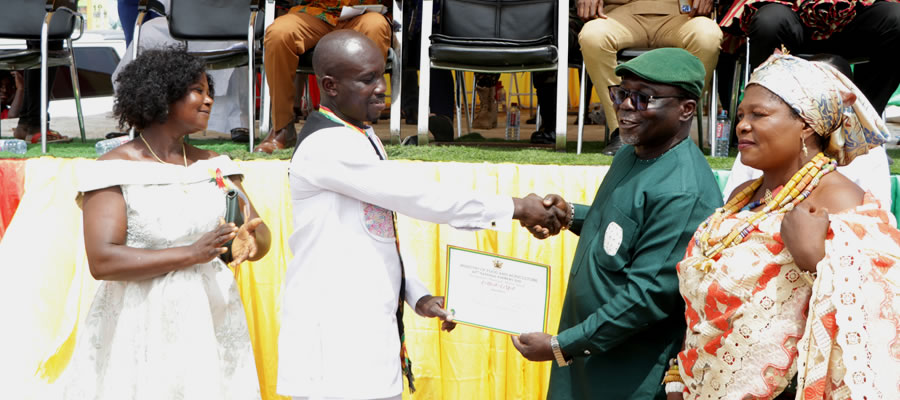

Introduction
The demographic characteristics of the population which receive most attention in demographic analyses are age, sex, migration, fertility and mortality. It is important that the size, composition and distribution of any population be analyzed to facilitate development planning, programme development and policy implementation. The current decentralized governance system and administration of planning in Ghana requires that statistics be provided on the size and distribution of the population at the local level. The population size, composition and age-sex structure, nationality, birth place, ethnicity, fertility, mortality and migration of the Ashaiman Municipality are discussed in this chapter.
Population Size and Distribution
The most fundamental demographic parameter is the number of individuals within a population (Lebreton et al., 1992). Table 2.1 shows population of Ashaiman Municipality by age, sex and sex ratio. Ashaiman Municipality is a one town Municipality and therefore has no rural settlements. The 2010 PHC results reveal that, the total population of the Municipality is 190,972 and the age group 0-4 years has the highest population representing 12.3 percent and age group 80-84 years constitute the least population of 0.2 percent.
On average, there are more females than males in the municipality as shown on the Table 2.1.
The data shows that for every 100 females in the Municipality, there are approximately 96 males. This conforms to other district figures in the region where there are more females than males. The sex ratio ranges from 66.6 - 124.2 with age group 60 - 64 recording the highest and age group 85years and above the least.
Age dependency ratio is an important tool for a developing population like Ghana and for that matter, Ashaiman Municipality. Table 2.2 shows that, the age group 15-64 are depended upon by the age groups 0-14 and 65+ with average age dependency ratio of 52.10.
The age dependency ratio of 52.1 means that on average more the one person in the active population (15-64) takes care of one person in the dependent age group (0-14 and 65 years and above) in Ashaiman Municipality. The table also shows that, age group (0-14 years) has a dependency ratio of 48.5 and age (65 years and older) has a dependency ratio
Table 2.3 shows the population size by locality of residence in the Municipality, the region as well as sex ratio. Ashaiman Municipality is made of the Ashaiman locality only, it is considered totally urban. The table shows that, the Municipality constitutes 4.8 percent of the total Greater Accra Region’s population and of the total population of urban dwellers in the region, Ashaiman Municipality constitutes 5.3 percent. From the table there are more females 50.9 percent than males 49.1 percent in the Municipality.
Age-Sex Structure
The age and sex structure of the population are the most important demographic characteristics that are captured by the population census. Age and sex are two attributes that largely influence an individual’s role in society (Riyaza, 2000).
The age-sex structure is graphically represented by a pyramid in Figure 2.1. A population pyramid is a graphical way to show the age and sex composition of a population. The figure indicates a broad base which is much broader at the age group 20-29 years but which narrows as the population ages peaking after age 45 years. The phenomenon is interesting to observe as the figure shape differs a bit from the normal pattern of a developing countries in general.
For both sexes, approximately the same number of females and males survive to higher ages although there are more males than females in the age group 0-4 years. The Population and Housing Census of 2010 further shows that in the Ashaiman Municipality, 12.3 percent of the population are under five years of age while 68.1 percent are aged 15 years or more. The population of the municipality is therefore very active.
Fertility, Mortality and Migration
The levels and changes of the three components of population- fertility, mortality and migration are important for socioeconomic planning and policy adoption in the decentralized system of governance in Ghana. Aspects of these, covered by the 2010 PHC are relevant for the socio-economic planning and policy adoption of the Ashaiman Municipality and are therefore examined in this section.
Fertility
Table 2.4 displays fertility rates for all districts in the Greater Accra region. From the table Ashaiman Municipality has a total fertility rate of 2.6 same as the regional figure and a crude birth rate of 23.7. The municipality has a general fertility rate of 77.5 which is a little above the regional average of 75.7 per one thousand women (age group 15-49 years).
The total fertility rate varies among the districts in the region, ranging from 2.17 in Accra Metropolis to 3.75 in Ga South Municipal. This pattern is repeated in both the general fertility rate and the crude birth rate where Accra Metropolis records the lowest rate (63.4 and 20.0 respectively) and Ga South Municipal is the highest (108.8 and 31.8 respectively).
The 2010 PHC questionnaire data from responses to questions on “births and deaths in the last 12 months” and those obtained from responses relating to children ever born and children surviving are used in estimating fertility and mortality rates as proxy measures of social and economic development or as specific indicators of the health status of the population.
Children ever born and Children surviving are presented in Table 2.5. Fertility rate is very high for the women between the age brackets 25-54 years. It is observed that, out of the total number (118,007) of children ever born in the Municipality of the female population 12 years and older, 89.2% are surviving which means that 10.8 percent of the children have died showing a rather very high level of mortality in the Municipality.
Mortality represents another component of population and its dynamics. The 2010 PHC measured mortality rates on the responses to questions on “births and deaths in the last 12 months”. Table 2.6 shows that 738 deaths representing 0.4 percent of the total population of the Municipality was recorded in the last 12 months before the 2010 PHC. Accra Metropolis recorded the highest number of deaths representing 0.44 percent of its total population and Adenta recorded the least number of deaths with 0.34 percent of its total population. The table shows that Dangbe East has the highest crude death rate of 8.60 per 1000 population while Ga West has the least crude death rate of 3.34 per 1000 population. The crude death rate of the Municipality is 3.86 per 1000 population and this is less than Tema Metropolis’ rate of 4.32 per 1000 population.
Table 2.7 shows the causes of death by district in the region. It is interesting to note that, the Ashaiman Municipality is the second highest after Dangbe West in deaths caused by accident/violence/homicide/suicide constituting 16.7 percent of the total deaths recorded in the Municipality. Dangbe East has the least (10.0%) deaths due to accident/violence/homicide/ suicide.
Death rates are calculated for specific age groups in order to compare mortality at different ages or at the same age over time. The age specific death rate is computed as a ratio of deaths of people in a specified age group, for example deaths among the 20-24 year-age group to the population in that age group (20-24 years) multiplied by 1,000. Figure 2.2 shows that the rates among females were higher than those of males in the age group 25-54 years, a possible indication of a relatively high maternal mortality rate in the Municipality. However, the age-specific death rates for females are relatively lower than for males in age group 55-70+ years and the age-specific death rate for the age group 0-24 years are approximately the same for both sexes. The estimated mortality pattern exhibited in Figure 2.2 is similar to patterns observed in other Assembly in the region.
Migration
Migration represents another component of population and its dynamics. Its measurement can be done in a number of ways. The PHC2010 measures migration with respect to nationality and birthplace as displayed in Table 2.6. Out of the total population of 190,972 in the Municipality, 61.7 percent (117,861) are migrants (born elsewhere in the Greater Accra Region or other regions in Ghana or outside Ghana). Those born in the same locality of enumeration are 38.3 percent (73,111). It is observed that persons born outside the Greater Accra Region but reside in the municipality are dominated by those born in the Volta region who constitute 34.8 percent (32,797) out of the total number of migrants (outside the region) whilst Upper West region is least with 0.7 percent (648).
Table 2.8 also shows that 26 percent of migrants from the Municipality have resided in the Municipality for a minimum of one (1) year and a maximum of four (4) years while approximately 13 percent of migrants have resided in the municipality for less than one year.
Date Created : 11/17/2017 7:26:17 AM











 facebook
facebook
 twitter
twitter
 Youtube
Youtube
 +233 593 831 280
+233 593 831 280 0800 430 430
0800 430 430 GPS: GE-231-4383
GPS: GE-231-4383 info@ghanadistricts.com
info@ghanadistricts.com Box GP1044, Accra, Ghana
Box GP1044, Accra, Ghana